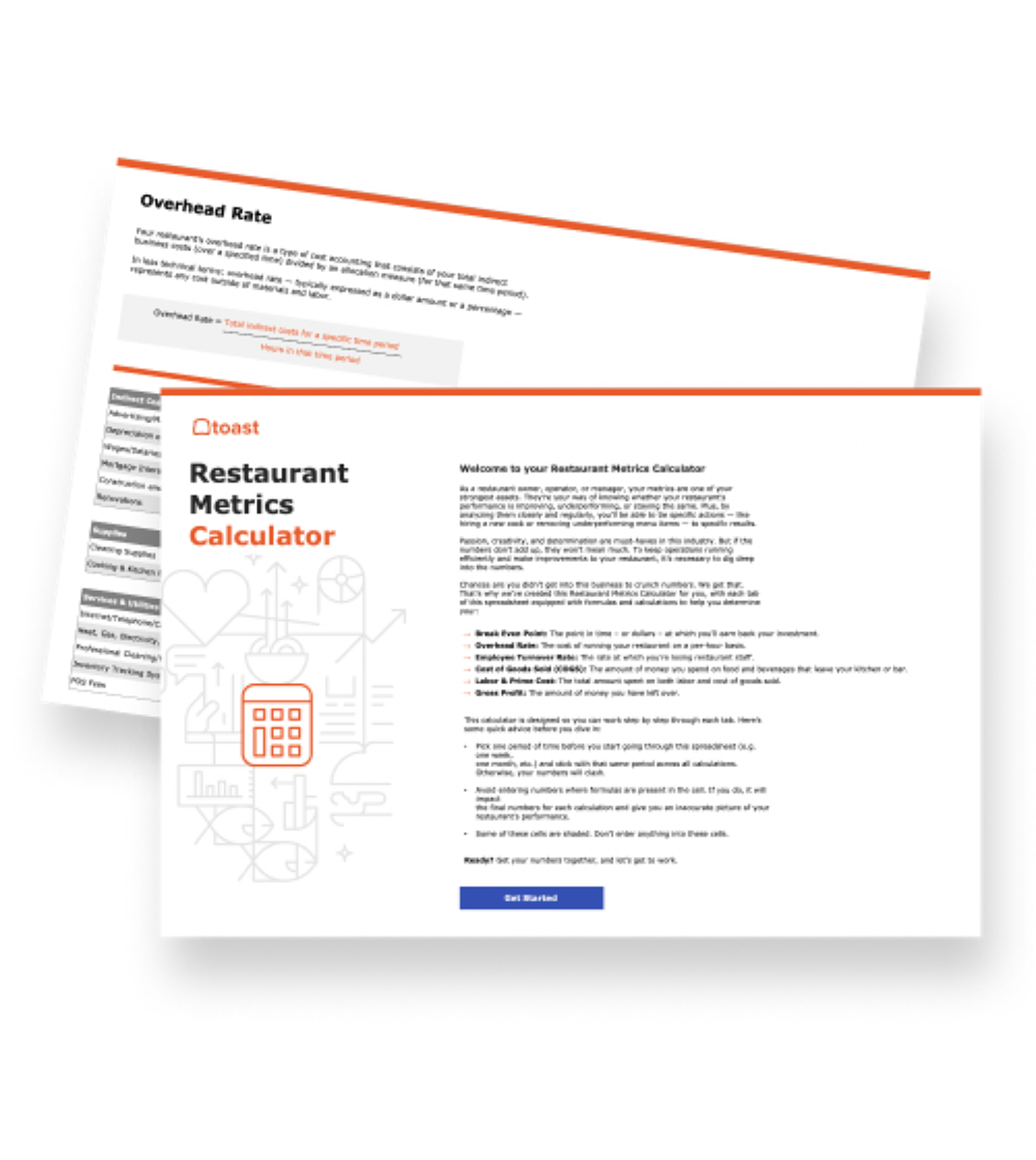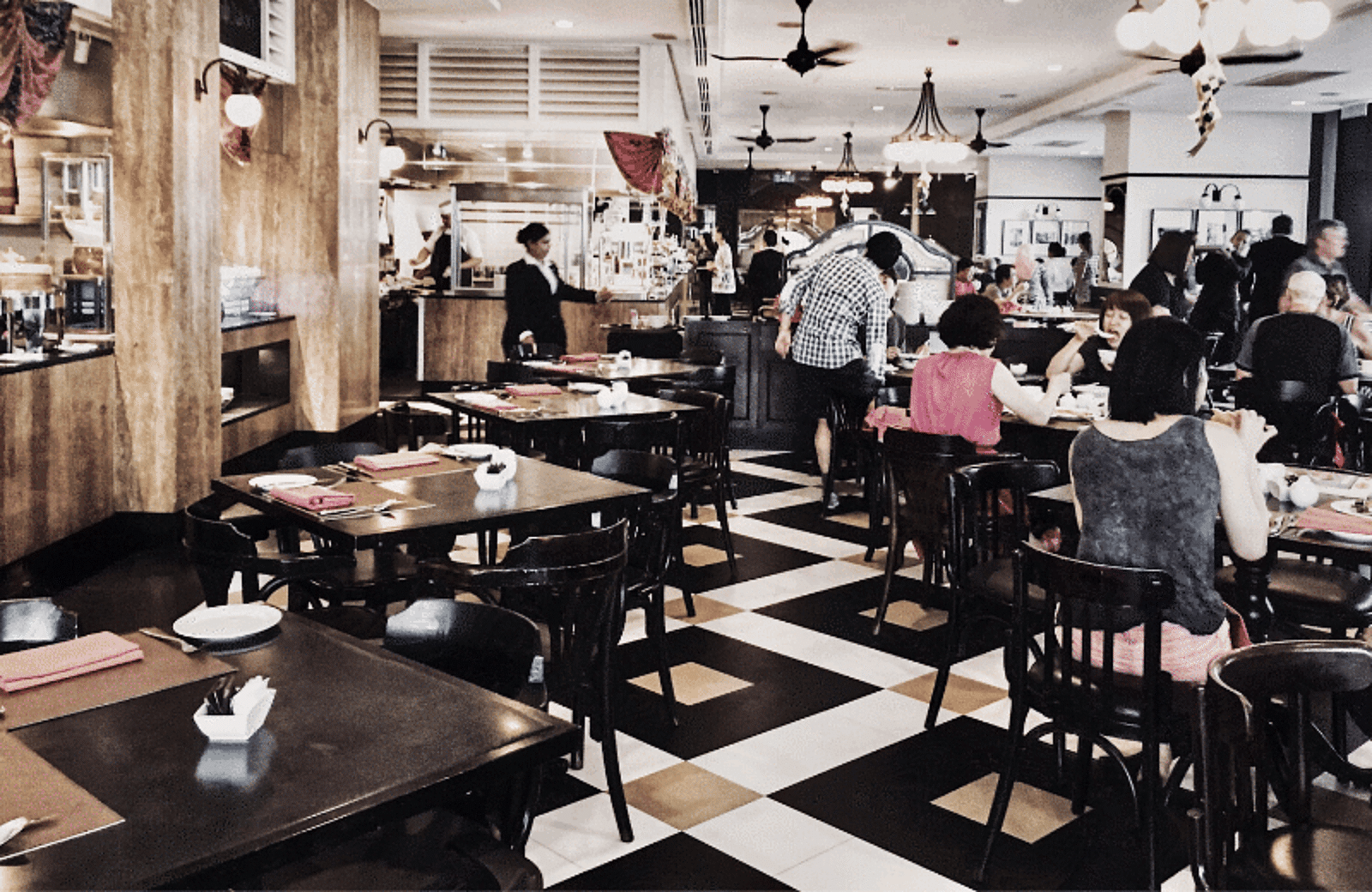
How To Calculate Restaurant Overhead Rate
Here's how to calculate, and effectively reduce, your restaurant's overhead rate — without compromising your guest experience.

Chris de JongAuthor


Restaurant Metrics Calculator
Use this free calculator to calculate the key restaurant metrics needed to understand the health and success of your business.
Get free downloadWhat makes a restaurant successful? A line out the door? A million 5-star Yelp reviews?
Here’s the truth: A “successful” restaurant is a profitable one.
Profitability is simply a measure of how much money you’re bringing in after all your expenses have been paid. And while that sounds straightforward, it’s tricky for even the most seasoned, financially-minded restaurateurs to calculate and (most importantly) to know where to start.
The best place to start is by calculating your restaurant overhead rate. Ask yourself these three questions: Do you know how to calculate overhead rate in your restaurant? If you don’t, how are you measuring profitability? …are you measuring profitability?
If your answers to these questions fall somewhere between “nope” and “I have no idea,” you’re in the right place. Together, we’ll be tackling all things restaurant overhead, including:
Why understanding overhead rates is crucial for restaurateurs;
How to calculate your restaurant overhead rate (complete with formulas and an easy-to-use calculator); and
5 ways to reduce your restaurant overhead to boost profitability.
Download the free restaurant numbers and metrics calculator below and follow along.
Restaurant Labor Cost Calculator
Unlock the power of data-driven labor management with our free Restaurant Labor Cost Calculator. Stop guessing and start optimizing your staffing decisions today.

What is Overhead Rate?
Your restaurant’s overhead rate is a type of cost accounting that consists of your total indirect business costs (over a specified time) divided by an allocation measure (for that same time period), including:
- Rent
- Salaries
- Utilities
- Advertising

In less technical terms: overhead rate — typically expressed as a dollar amount or a percentage — represents any cost outside of materials and labor.
To keep their business afloat, many restaurateurs will jack up their price per menu item, but as you’ll see in a minute, there are other, craftier ways to drive that number down.
In business, there are plenty of indirect costs (rent, salaries, etc.), and a bundle of allocation measures. With allocation measures, however, you’ll most often find businesses using direct labor hours (though there is a time and place for alternatives like direct labor costs and even inventory costs).
Why Is Overhead Rate Important?
It’s simple, really: lower overhead means greater profit. And as any restaurateur will attest, anything you can do to nurture your restaurant profit margin is a worthwhile investment.
Once you’ve roughly estimated your restaurant overhead rate, you can begin strategizing ways to bring that number down (without compromising your quality of service, of course).
Calculate Your Own Restaurant Overhead Rate
Using the example of direct labor hours, here is a calculator to compute your own business’ overhead rate for one month.
To use it, simply total up your indirect business costs for a month and input that value in the first line. Then total up your direct labor costs from your employee scheduling software and input that value into the second line. The output value will be your overhead rate expressed as a percentage.
Example: How to Calculate Restaurant Overhead
Meet Joe. Joe owns a popular independent full-service restaurant who recently reduced his hours of operation. He’s interested in calculating his restaurant’s overhead rate for the month to determine how this operational decision will impact his bottom line.
In the past, Joe’s overhead “sweet spot” hovers around $25.00.
What Joe Needs
- A total sum of indirect costs (things like technology, advertising and marketing, and rent). These costs work out to $20,000.
- An allocation measure — in this case, the total number of scheduled labor hours. A quick look at Joe’s restaurant scheduling software lets him know his team is scheduled across 600 hours.
What Joe Does
Using the ‘Overhead Rate = Total Indirect Costs / Allocation Measure’ formula (or the handy calculator we’ve built for you above!), Joe learns his overhead rate is $33.33.
-1.png)
It’s important to mention overhead cost can be calculated using either actual costs or budgeted/forecasted costs. Which route you choose gives context to the number your calculator spits out: if you’re working with forecasted figures, you’re computing a predetermined overhead rate.
This rate is essentially an educated guess, and is a great way to model or map out your operations.
5 Ways to Lower Restaurant Overhead Costs
As you can imagine, Joe wasn’t thrilled with the $33.33 result.
The good news, however, is there are ways for Joe (and you) to shave off some excess to improve restaurant profitability. While there isn’t a one-size-fits-all solution, some or all of the following five strategies may help you drive your costs down and your profits up:
1) Reduce Your Restaurant Labor Costs
When tasked with reducing a restaurant’s overhead rate, many restaurateurs head straight for the indirect costs. However, an often overlooked and underestimated alternative is to reduce your labor hours allocation.
It’s possible your restaurant’s employee scheduling software seamlessly integrates with your restaurant POS system. If it does, you’ll have easy access to data from both pieces of technology to spot trends and discrepancies.
For example, you might discover you are scheduling one too many servers on weekday evenings; this a simple fix with sizable gains, since adjusting your monthly labor hours (and associated labor costs) can dramatically reduce your overhead rate.
2) Ask Your Staff
Another way to reduce overhead is to use the collective knowledge of your staff.
Sometimes restaurant managers and owners incorrectly assume they have eyes on all corners of their business, when in reality they should be turning to their FOH and BOH teams for juicy (and sometimes surprising) operational insights. Your staff are a valuable resource and can help you spot excess overhead you might otherwise have missed.
To keep your team in an “optimization mindset,” implement a reward system for staff who identify overhead drivers. Something as simple as a gift card or a work-free weekend can go a long way. After all, incentives work!
3) Optimize Your Restaurant Technology
Another major overhead culprit is legacy technology.
Landline telephones, clunky POS systems, and dated management and payroll software might incur lower fees, but the impact on your bottom line is not to be ignored. Investing in modern, user-friendly technologies opens the door to things like automation and an infinitely more robust set of features, data, and analytics.
4) Reduce Waste
Stop ordering inventory for bulk discounts. Spoiled food spoils your profitability. Instead, focus on reducing inventory wastage; just-in-time (JIT) orders, regular stock audits, and making sure to reconcile deliveries with purchase orders will help you in this pursuit.
And let’s not forget about smart inventory solutions like BlueCart that will automatically place an order for you when supplies are running low and Toast's integrated inventory software which syncs directly to your POS.
5) Sublease Space
Unless you operate a food truck or a pop-up restaurant, your physical storefront accounts for a substantial chunk of a restaurant’s indirect costs.
While the most obvious tactic is to negotiate the best lease possible for your restaurant (or consider renting it if market forces allow), another option is to sublease your space to a complimentary business. For example, if your business operates a lunch and evening service, consider subleasing your kitchen space in the morning to a caterer or food truck who can enter, work, and leave without impeding your ability to do business as usual.
Restaurant Overhead Rate
Calculations aren't every restaurant owner's cup of tea, but they're an important part of the job that help keep your doors open.
Take some time, do the math, and start working on ways to lower your over head rate.
Related Restaurant Financial Resources
Restaurant Cost Control Guide
Use this guide to learn more about your restaurant costs, how to track them, and steps you can take to help maximize your profitability.

Is this article helpful?
DISCLAIMER: This information is provided for general informational purposes only, and publication does not constitute an endorsement. Toast does not warrant the accuracy or completeness of any information, text, graphics, links, or other items contained within this content. Toast does not guarantee you will achieve any specific results if you follow any advice herein. It may be advisable for you to consult with a professional such as a lawyer, accountant, or business advisor for advice specific to your situation.
Read More
Subscribe to On the Line
Sign up to get industry intel, advice, tools, and honest takes from real people tackling their restaurants’ greatest challenges.



